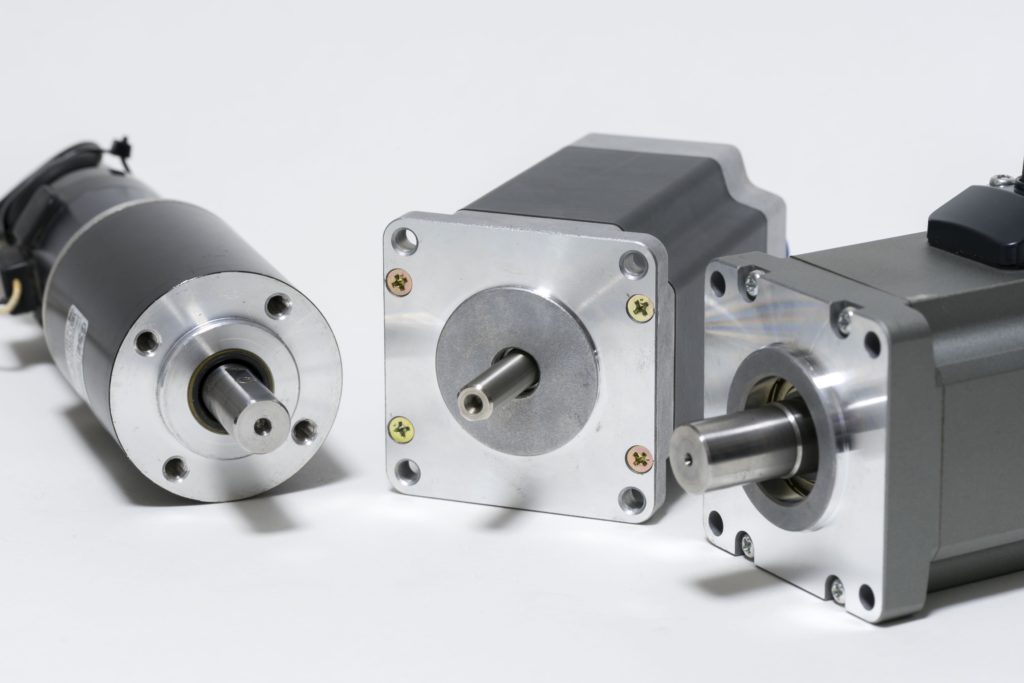Servo Motor and Drive Troubleshooting Guide


Quick Links: Common Servo Motor Issues | How to Repair Servo Motor Components | Need Help After Troubleshooting?
A servo motor is a torque-based engine comprised of a rotary actuator or linear actuator. This type of motor allows for precise controls adjusting for angular and linear position, torque, velocity and acceleration. Four components, motor, a drive, controller and feedback unit, comprise modern servo systems.
Servo motors are usually quite small, but they still pack a lot of power and efficiency which is why a lot of applications use them, namely industrial. You’ll find them in industries like robotics, metal cutting and forming, printing, woodworking, conveyor belt setups and more.
When selecting a servo motor, the inertia load should never exceed ten times its capabilities. Many different types of servo motors and drives exist but all are a means to an end. Ultimately, they power industrial grade equipment and machines and keep a plant fully operational. But like anything, they can malfunction.
When that happens, it can be costly for your company and crew. Repairs can take longer if you don’t have an experienced maintenance team, leaving the equipment offline for hours, days, or even weeks.
It’s always good to have backup equipment that you can replace malfunctioning devices with, especially if you need to ship the affected machine or motor out for repair. Shipping out to fix a problem can also take an extended period and exacerbate the downtime of your team or equipment.
Browse through this troubleshooting guide to see if you can identify and fix the problem before calling in a repair team or shipping your gear out for repair as it can save you time and money.
Common Issues and Possible Causes: Servo Motor Troubleshooting
Any piece of hardware or equipment will encounter problems after a while, but the more common problems can usually be handled if you know how to deal with them. Some of the more common problems will happen regardless of maintenance or upkeep, and may even cause a motor failure in the middle of an operation.
Before you begin pulling apart the servo to inspect components, you’ll want to see if there’s a quick fix. Here’s a brief list of issues your team might come across, and what they can do about them:

Overheating
Believe it or not, most servos are susceptible to heat, especially when they’re running for extended periods of time. While maintenance crews do report a higher call volume for overheating during summer months, it can happen even during cooler weather.
Servos can overheat for a number of reasons, like the increase of indoor and outdoor temperatures, extended operating times, poor ventilation or even the condition of your company’s equipment. Older machines tend to overheat more often as their internals wear out.
An overheating servo is never good because the elevated heat levels can damage your equipment and even ruin other parts of your connected system. Any good servo will have a failsafe, of course, and shut down when the temperature surpasses a dangerous threshold. That doesn’t change the fact that it can cause severe damage to company’s equipment and waste a lot of your team’s time.
Ensure your plant is climate-controlled and keep the temperature inside regulated as much as possible. You don’t necessarily need to keep it freezing inside your plant, but you do want to prevent temperatures from climbing too high in general.
Furthermore, never attempt to cool the servo while it’s running by opening the cabinet door or placing a fan nearby. This tactic will only put extra wear on the system. Excess dust and dirt can and will seep in, damaging components.
If the overheating equipment is old, have it serviced, and make sure the major components are in proper order. You may need to replace a few — or several parts — especially when it comes to an older motor.
Finally, always make sure to turn off an overheating system and let it cool off for a decent amount of time. If this becomes constant, where the equipment is idle more than it’s operational, you may want to consider replacing it.
Servo Motor Won’t Turn
Every once in a while, you might come to find that your motor just isn’t moving. This discovery may seem like bad news since a servo motor has so many components that it can be difficult pinpointing the exact problem. If you know this quick tip, however, that’s not the case.
Just check the controller’s Digital-Analog-Converter output. If you find a DAC parameter value of 0 or just shy of it, then that’s why the drive is not moving. There’s something wrong with the controller, and you may need to replace it. But if that number is larger, then the controller is doing what it’s supposed to, and you can move on.
If the equipment problem is because of the drive, then you should be able to run a self-test. This test forces the motor to operate at a low efficiency so that you can see whether or not it’s working properly. If nothing happens, then you know the problem is with the drive.
Servo Making Abnormal Noises
A servo motor will always make a small amount of noise, it’s natural. Humming is the most common noise a servo drive or motor will produce during normal operation.

That said, it should never be loud to the point of being obnoxious. If the servo does make strange noises, the problem is most likely incorrect wiring or electrical issues. Check to make sure the servo is grounded properly and that it’s getting the appropriate amount of power. Obviously, be sure the servo is off before working on the electrical circuits.
Servo Motor Producing Reduced Torque
Torque is the amount of muscle, energy or power required to rotate and move a mechanism. It comes from three basic sources: friction, external forces like fighting gravity and accelerating a mechanism’s inertia.
By nature, motors will only put out a certain amount of torque so that if you choose the wrong one, it may not be able to handle the workload your team needs it to. Sometimes, you may also have a servo motor malfunction, and it will cease producing enough torque. Some of the most popular servos operate between 4.8v and 6.0v which is 130.5 oz-in and 152.8 oz-in respectively.
Aside from the motor not having enough power, here are some other things you can check:
- The servo amplifier rating.
- The servo’s workload limits.
- Low voltage or voltage drops within the system.
- Bad capacitors.
- Inadequate or improper connections.
You and your team will want to become familiar with how to test servo motor and drive systems because this can often happen, especially with older and dated equipment.
Servo Smells Funny or Produces Smoke
More than likely, if your servo produces a strong odor, it’s going to be reminiscent of something burning. If you notice this or see smoke of any kind, it indicates that your system is overheating.
Check the cooling system or air flow to ensure it’s not restricted in any way. If your servo is already exposed, ensure that nothing like dirt or dust particles made its way inside. If neither of these steps help, check to see if the bearings are in proper order. They can have several issues including too much lubricant, worn bearings and overheating.
You may also encounter the smell of ozone, which indicates burning windings or wiring. If that’s the case, you need to ensure the wires are contactless and the system is grounded properly.
Servo Motor Shuts Off After Reaching High or Full Speed
If your servo motor starts fine but turns off after reaching a high speed, it indicates a serious malfunction. This problem may be a little harder to repair. A few factors may cause your motor to shut off, such as:
- Defective overload protection system.
- Rapid overheating.
- Inadequate or improper bearings.
- Blown fuses or old ones in need of replacement.
- Bad capacitors.
- RPM meter malfunction or inaccurate readings.
- Voltage drops or poor wiring.
Depending on what you and your team find, you can begin repairs on your servo motor or contact a professional to fix your equipment.
How to Repair Servo Motor Components: Fixing the Problem
Once your maintenance crew has identified the problem, you can move on to the actual repairs. Before you do, take note that most of the problems or indicators are similar. Bad capacitors, for example, can be responsible for several problems, and the same applies to voltage drops or shoddy wiring.

Make sure you have the appropriate testing tools and meters before moving on to the next section. As a forewarning, this equipment is more complex, so you will not be able to find it in conventional retail stores.
Troubleshooting and Repairing
Servo drive troubleshooting and servo motor troubleshooting are the lifeblood of identifying and fixing a problem. The ultimate goal is to work with and sometimes operate the servo to deduce what’s going wrong. Luckily, most servo drive and motor systems are attached to an alarm which will sound when something is up.
WARNING: Troubleshooting a servo drive can be a complex and dangerous process. It requires working knowledge of electromechanically controlled motors, actuators and a volt-ohm meter. If any of these components seem foreign to you or your team, outsource help. While reading up on how to repair servo motor and drive system, you’ll want to be prepared before taking action.
Your servo may be slightly different than what we are describing, yet the following troubleshooting steps should remain the same:
- Before supplying power to the unit, inspect the MOSFETs, inputs and outputs, IGBT’s relays, feedback circuits, power supplies and capacitors.
- Turn on the machine or main breaker and check the LED or readout display. If there is a screen and it does not come on, make sure there is power supplied. If the alarm comes on immediately before anything else powers on, then your problem is probably the servo drive. If the drive begins working before the alarm sounds, you can rule it out.
- Inspect the servo drive and motor to identify missing, broken or bent parts.
- Check the motor or cable plugs. If you notice any irregularities, you may need to replace these components.
- Review the diagnostic or lead meters to see if there’s unnecessary friction in the motor axis. Friction is a rare problem, but it can happen and usually does when there’s too little — or too much — lube.
- Inspect the motor box coolant or air flow system. Make sure to clean or remove particles, dry out any plugs and check all cables.
- Check for a bind in the axis or if the brushes are worn down in the DC motor.
- Use a volt ohm meter to check for an incoming power supply. You’ll mainly want to test the servo drive to ensure the voltage is correct.
Of course, your maintenance team may run through all these steps and still have trouble identifying what’s wrong. That’s okay.
Look at these questions and see if they fit the problem your equipment is having:
- Does the alarm sound, or does the motor have problems in feed or during rapid movement? There may be a bind.
- Is there a loud hum coming from the servo motor? Your motor axis likely has a bind.
- Is there a loud growl or similar noise during high-speed operation? The bearings are bad.
- Does the motor slows down or stops abruptly? You might have an electrical problem. Check to make sure that coolant didn’t seep into the electrical box or one of the axes.
Once you complete a repair or replacement of parts, you’ll want to test the servo motor before putting it back into regular operation. You can do this by plugging it into a universal tester, which will provide information on the feedback, phases, rotation, speeds and direction under load. Also, don’t subject it to a heavy workload right away. Ease it back into operation by starting slow, just to ensure everything is in proper working order.

If you need specific repair instructions for the various components, you can find a comprehensive guide here.
Need Help After Troubleshooting?
Even after the most rigorous troubleshooting and upkeep regimen you and your team may still need help getting the servo up and running again. At this stage, your team may not want to admit that they need help, but it’s perfectly okay. When you use a reliable servicing company — like Global Electronic Services — we’ll have you back in operation in no time, and we won’t sweep away all your profits to do it.
Global Electronic Services technicians will do everything from inspecting the motor to performing necessary fixes and painting the station. Before shipping anything back, the quality control team will check and audit the components to ensure that everything is functional.
We offer you complete servo motor and repair assistance and we operate with a qualified team of OEM-trained servo technicians. Every tech follows a strict set of procedures when repairing servo motors and drives, which ensures that they can fix any damage or problem without creating more. Call us today!


